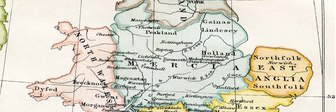YouGov reveals where the British public falls on the classic D&D alignment table
RPG players and meme lovers will all be familiar with the concept of the alignment table. The two-axis alignment table was introduced as far back as 1977, with one scale being that from Good to Evil and the other being from Lawful (which emphasises “honour, trustworthiness, obedience to authority, and reliability”) to Chaotic (which emphasises “freedom, adaptability, and flexibility”).
We at YouGov were curious to see where Britons would fall on this measure. During the summer YouGov asked 24,000 people to self-identify via two questions about their values in order to determine where they fall on the alignment table.
Now using YouGov Profiles we can reveal the results, as well as highlighting some key differentiators between the different alignments.
Except where figures are specifically stated, the information shown below refers to the biggest differences between groups, not necessarily the most popular answers.
The alignments
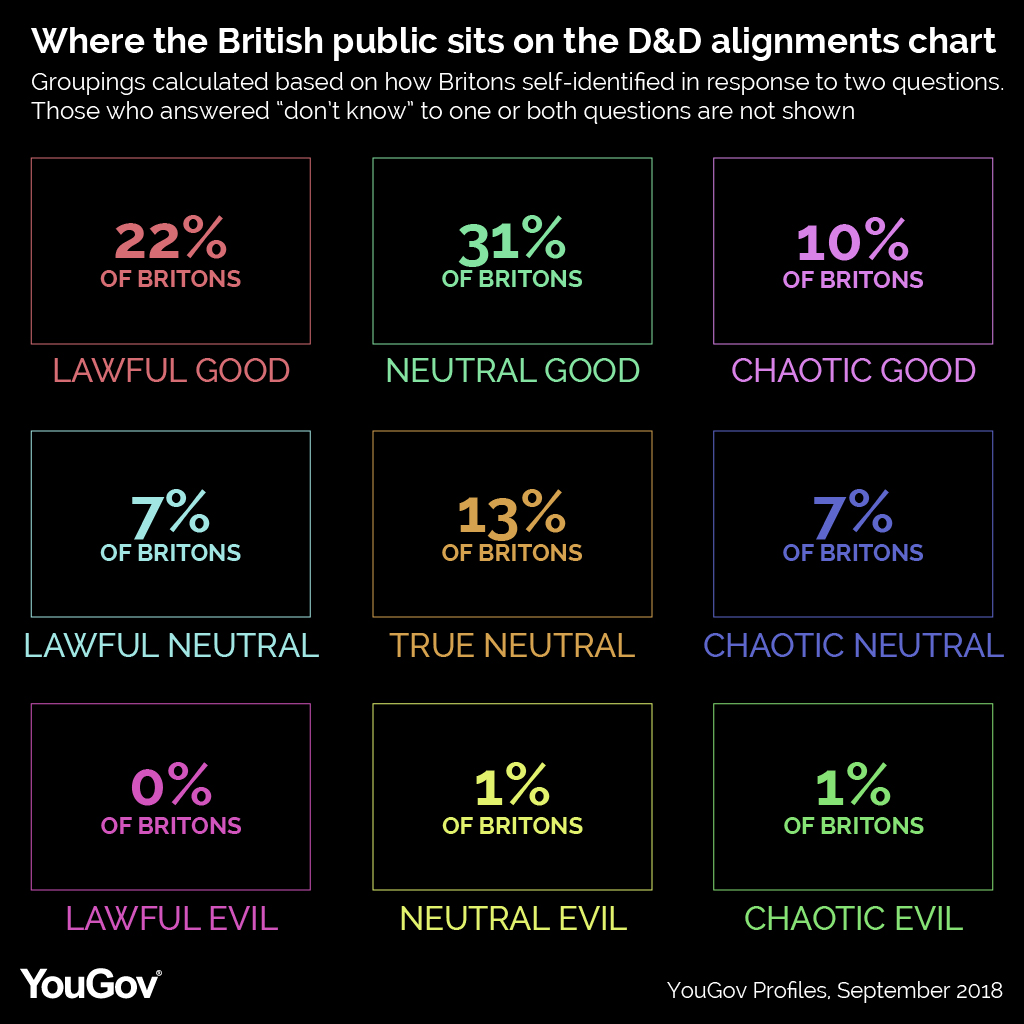
The most populous group is Neutral Good – that is those who consider themselves Good but fall in between Lawful and Chaotic – which almost a third of Britons (31%) come under.
The second largest group is Lawful Good, which holds just over one in five Brits (22%).
A further 13% of Brits are True Neutrals – rating neutrally under both scales – and 10% are Chaotic Good. The Lawful Neutral and Chaotic Neutral groups contain 7% of Brits apiece.
Only a very small proportion of people (fortunately) fall into any of the three evil groups: 1% in Chaotic Evil, 1% in Neutral Evil and a statistical 0% in Lawful Evil.
Because so few people self-identify as evil, the sample size for the three evil groups is too small to draw statistically significant results from, so only the six other groups will be examined in this article.
Demographics

Chaotic Neutrals are substantially more likely to be men, with a gender split of 65% to 35%. Also noticeably more likely to be composed of men are the Chaotic Good (58% men, 42% women) and Lawful Neutral (55% men, 45% women) groups.
These three alignments are balanced out by the largest of the groups – Neutral Goods – being more female, with a gender breakdown of 53% women to 47% men.
Chaotic Neutrals are the youngest group, with 22% being aged 18-24 and 35% aged 25-39. By contrast, the oldest group are the Neutral Goods, of whom 37% are 40-59 years old and 28% are 60+.
Public figures
The preferred public figures of the various groups highlight the extent to which Lawful and Chaotic are as much in opposition to one another as Good and Evil.
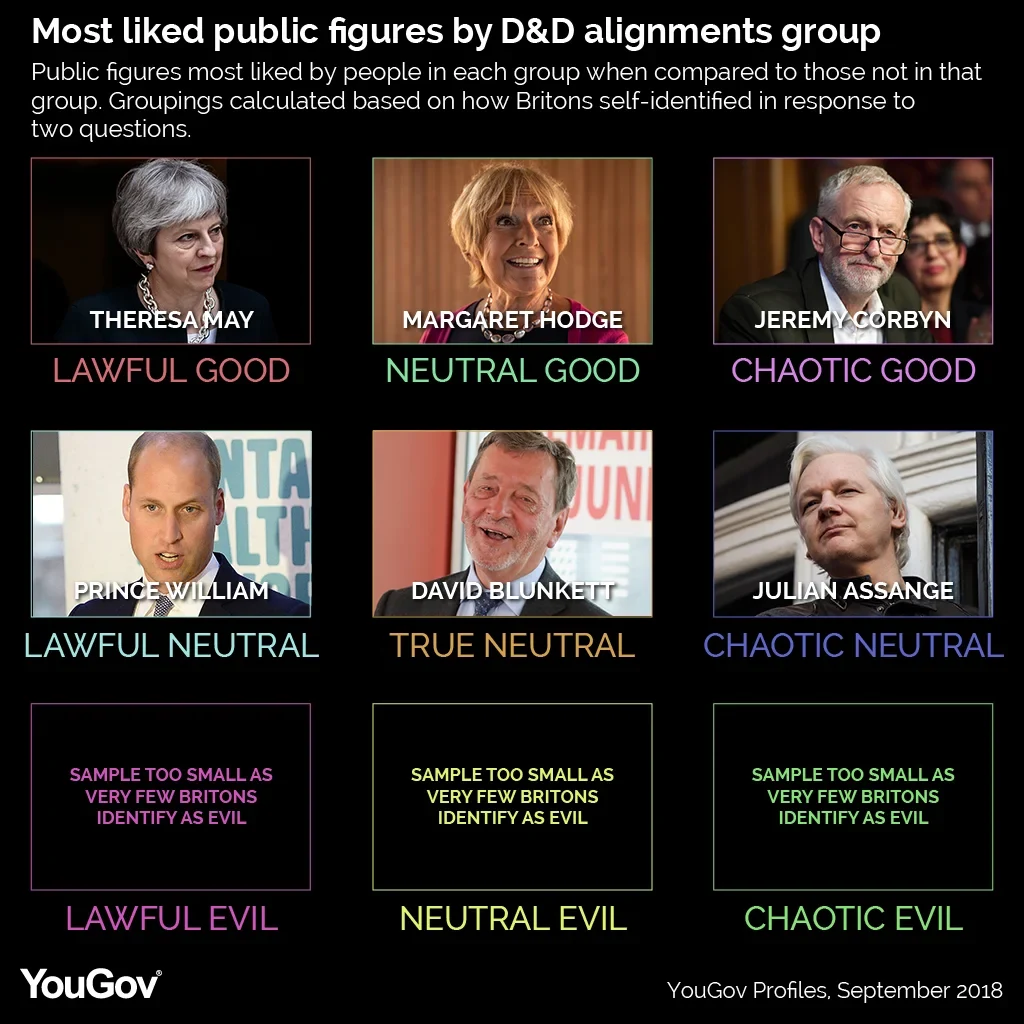
Among the Lawful Good group the public figure they like most compared to other groups is Theresa May. By contrast, the public figure that Chaotic Goods like most compared to other groups is Jeremy Corbyn.
Two further Labour figures top the lists, with Neutral Goods’ most preferred public figure being Labour MP Margaret Hodge and True Neutrals liking former Home Secretary David Blunkett.
Among Lawful Neutrals the most relatively favoured figure is Prince William, while Chaotic Neutrals have a thing for WikiLeaks founder Julian Assange.
Top issues
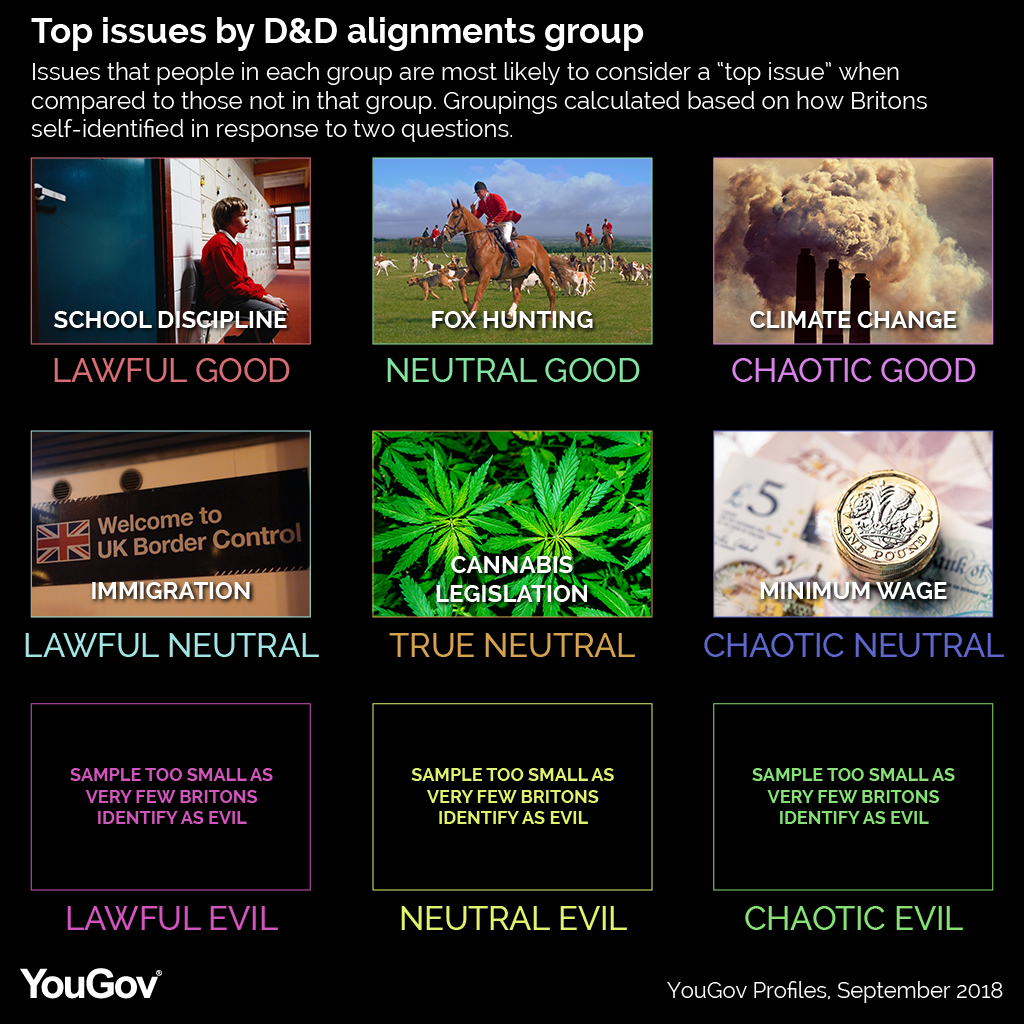
Given the value they place on obedience to authority, it is unsurprising to see that issue that Lawful Goods are most likely to see as a “top” issue compared to the other groups is school discipline. For Neutral Goods the top issue is fox hunting, and for Chaotic Goods it is climate change.
Lawful Neutrals are most concerned with immigration compared to the other groups, while for Chaotic Neutrals it is the minimum wage and True Neutrals are most fixated on cannabis legislation.
Statements agreed with about politics
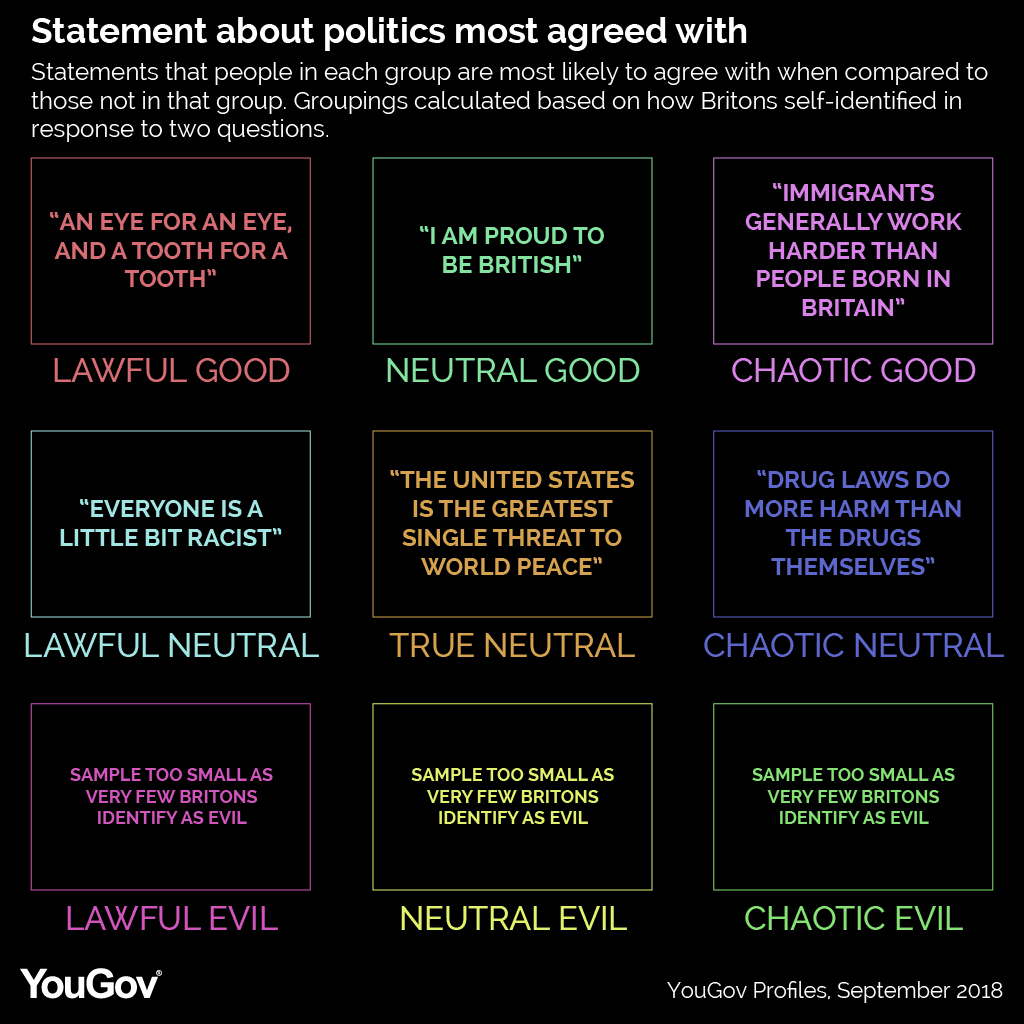
The kind of order that Lawful Goods seem to favour is indicated by the statement about politics they are most likely to agree with compared to the other groups: “an eye for an eye, a tooth for a tooth”.
For Neutral Goods, patriotism rules the day, with their statement being “I am proud to be British”. Chaotic Goods are more enamoured with the prowess of those from overseas, with the statement they are more likely to agree with than the other groups being “immigrants generally work harder than people born in Britain”.
Lawful Neutrals are most likely to feel that “everyone is a little bit racist”, while True Neutrals are most concerned that “the United States is the greatest single threat to world peace”. Chaotic Neutrals, by contrast, are worried that “drug laws do more harm than the drugs themselves”.
Voting behaviour
Among those who voted at the 2017 general election, Lawful Goods were the most likely to back the Conservatives, at 51%. Lawful Neutrals were also more likely to vote Conservative over Labour, at 45% vs 37% respectively.
The other four groups were all more likely to have backed Labour, with the strongest support coming from Chaotic Goods, at 52%.
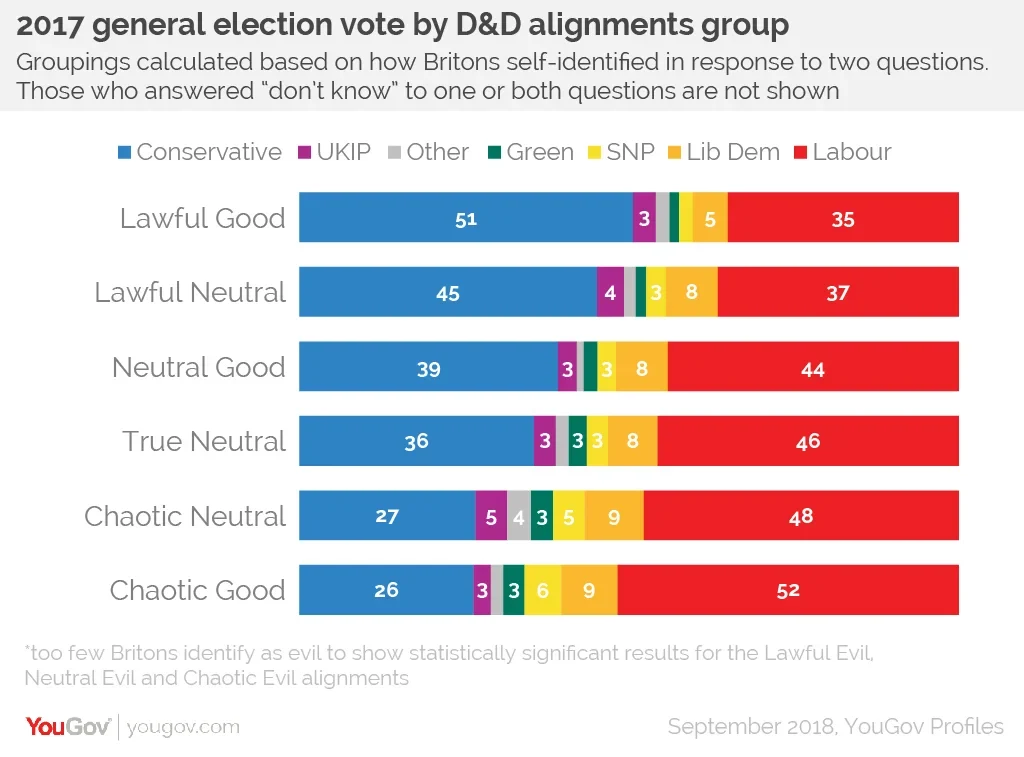
Regarding the EU referendum, Lawful Neutrals and Lawful Goods were the most likely to have voted to Leave, at 61% and 60% respectively. The division among True Neutrals and Neutral Goods was closest to the referendum result, with the former group backing Leave by 53% to 47% and the latter group by 51% to 49%.
The two Chaotic groups were more likely to opt Remain, by 53% to 47% among Chaotic Neutrals and 59% to 41% among Chaotic Goods.
Photo:Getty











